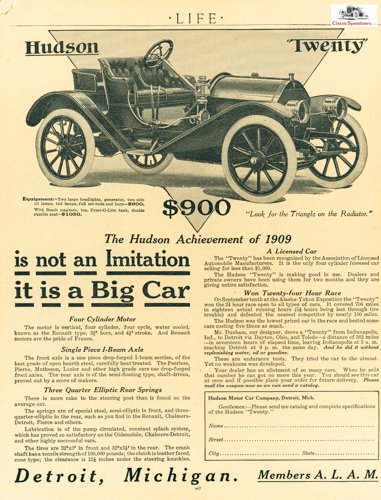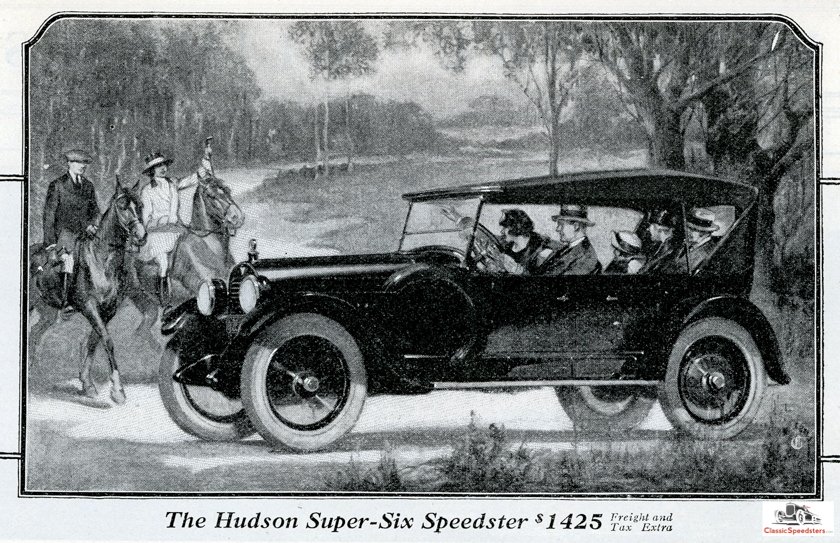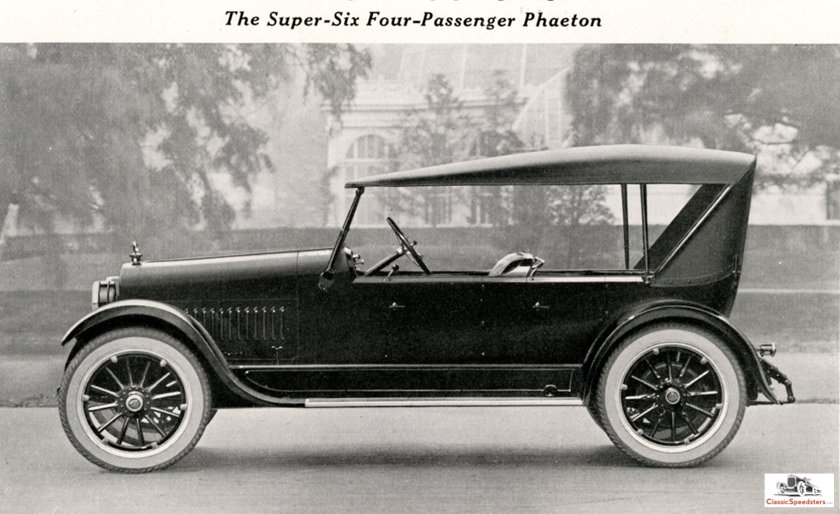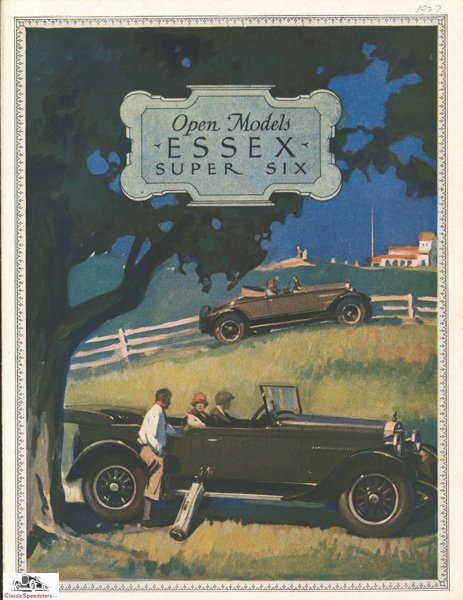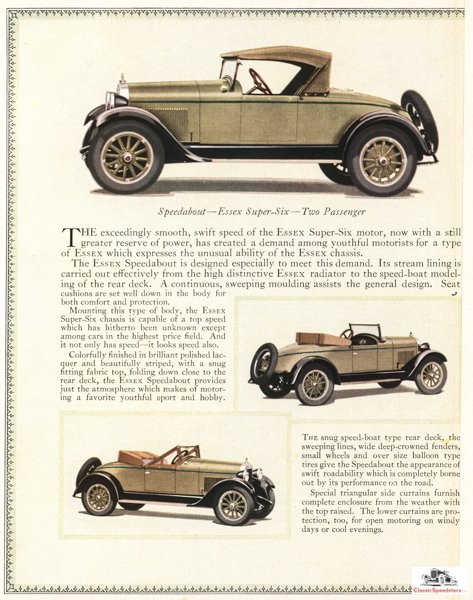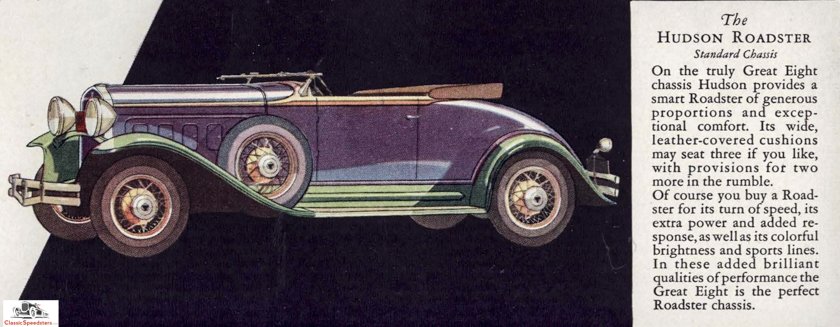Special Announcement
I’ve begun my Kickstarter campaign to bring in more readers of my book, Classic Speedsters. If you’d like to see what’s up with that, please visit the campaign at
https://www.kickstarter.com/projects/ronalddsieber/help-fund-my-book-production
More details follow at the end of this article.
Hudson Recap
Hudson benefitted from starting their company between two recessions, so supplies then were plentiful, and so too were interested customers. We covered that in more detail in a previous post on the early Hudson years. You can read more about that by copying and clicking on this link:
https://www.classicspeedsters.com/blog/2020/3/10/hudson-and-the-mile-a-minute-roadster
What follows is a brief recapitulation to set the stage.
Hudson seemed to be the right car at the right time, capitalizing on February 24, 1909 with $100,000 from department store owner J.L. Hudson, who got naming rights for his contribution.
1909 Hudson ad. all images courtesy AACA library unless otherwise noted
Roy D. Chapin and Howard E. Coffin, formerly of the Olds Motor Works, Thomas-Detroit, and Chalmers-Detroit, were at the helm of this new concern. George W. Dunham and Roscoe B. Jackson, also from Olds, had joined up; together the team brought a raft of confidence to this new motorcar’s success.
And successful it was! After one year of building its Model 20, between 4200 and 4500 runabouts had rolled out the door, a testament to selling just what the customer wanted—a low-cost car that worked!. Quite a first-year achievement!
1910 Hudson 20 Roadster
The Model 20 became Hudson’s bread-and-butter model to establish the company, but it was the Model 33 of 1912 that opened up the company’s potential to grow.
1910 Hudson 20 Roadster, front quarter view.
Along with the selection of models that were typical of this era, including a Model 33 Roadster, Hudson also trooped out a “Mile-A-Minute” Roadster.
1912 Hudson Mile-A-Minute Roadster
The Mile-A -Minute was a true speedster in that it presented in cutdown speedster style. It had a raked steering wheel and laid-back seats, and it was minus passenger compartment body panels when compared to the Model 33 Roadster as seen above. Plus, the Mile-A-Minute had smaller wheels.
To sum it all up, the Mile-A-Minute was a “stripper” in the true speedster tradition of the period. This car no doubt gave birth to the expression—“Goes like 60!”
The Interim Years
Hudson steadily increased market share as it first competed with Ford for a piece of the low-cost market of four-cylinder cars, and then inserted itself into the automotive middle sector with upmarket models using the Hudson Six. This began in 1913, and by 1914 Hudson was all about six-cylinder cars.
1916 Hudson - Factory. image courtesy HCFI library
Steady growth allowed Hudson to expand into its Alfred Kahn-designed factory in Detroit by 1916, where sales doubled to 25,000 units that year.
1912 Hudson Racing ad
Hudson cars had been raced since 1912 as a way to test components and engineering practices, but factory support to achieve records really came on in 1915. Their Hudson Super Six, the first six with a balanced crankshaft, had a long-stroke 3.5” X 5.0” L-head design, displacing 289 cubic inches and producing 76 horsepower at 3000 rpm. The Super Six earned a reputation as being a contender as the company campaigned at various board tracks as well as hillclimbs, setting records and winning laurels for endurance records and road race finishes.
1916 Hudson Super Six engine. image courtesy HCFI library
Some privateers altered the stock Hudson chassis and mounted their own racing bodies to compete on tracks with the big boys, who often drove purpose-built raceware.
1917 Hudson Super Six race car. image courtesy Philadelphia Free Library
The stock Super Six chassis was 125.5 inches, with a tread of 56 inches. Where they would cut—most likely between the two lateral crossmembers that frame the muffler in the diagram. What’s your guess?
1916 Hudson - Super Six chassis. image courtesy HCFI library
Hudson track speedsters were known as scrappers that could well achieve a second- or third-place podium, which thus placed them on the leaderboard, but they were more often in the middle of the pack rather than at the head. Hudson briefly fielded a professional team of three cars in 1917, but by mid-1918 they dissolved it due to the onset of America’s involvement in WWI. Hudson never formally reconvened the team, but privateers made use of Hudson’s sterling six to compete (and sometimes win) in events on up into the 1930s.
The Super Six Speedsters
As an historical aside, Hudson had introduced a four-passenger model in their 1922 Super Six line called the “Speedster.” This Super Six would continue until 1925 alongside its sibling, the Phaeton. Both rode on a 125.5-inch wheelbase until 1924, at which point Hudson increased the wheelbase to 127.5 inches. Both weighed about the same, a middleweight at 3400 pounds. All model years used the venerable Hudson Super Six iron block 289 which produced 76 bhp at 2450 rpm.
1923 Hudson Super Six Speedster. Pay attention to the door knobs.
1922-25 Hudson Super Six Speedster. The rear doors had a reverse or “suicide” opening.
In essence, there was nothing special about this model that one would call “speedsterish.” The Speedster body was allegedly narrower and had a lower beltline than the standard phaeton/touring sibling, In addition, Speedsters had (rear) suicide doors, Phaetons had suicides for both front and rear (check out the doorknobs).
1922-25 Hudson Super Six Phaeton. Note the placement of the door knobs in this model.
1923 Hudson Super Six Phaeton (4-pass)
Owners of these cars state that they were favored by bootleggers because they were nondescript and fast, but this model seemed to be more of a marketing ploy rather than a serious speedster. Those would come later.
Essex Leads the Way
In 1919 a new model, the Essex, was introduced as a way for Hudson to re-enter the low-cost field. The four-cylinder Essex, displacing 179 cubic inches and using an F-head arrangement for its valvetrain, would compete directly with the likes of Ford and others who dominated this sector, and the larger Hudson would continue to go up against middle-market contenders with its Super Six 289.
1927 Essex brochure
Essex steadily worked on its quality with product innovations that it adopted from its parent, Hudson, but not all improvements improved. For instance, after adopting the Super Six in L-head configuration in 1924, which had a diminished 145 cubic-inch capacity when compared to the 179-inch four, Essex had replaced a powerful and dependable four-cylinder engine with a wimpy six—a faux pas.
Nevertheless, Essex was the first in its market sector to offer a hard top, which meant that there was now a low-cost sedan for the budget minded in addition to the usual selection of phaetons. Hudson and Essex increased market share to become third in combined sales by 1925, and by 1928 had total sales of over 300,000 units!
The Essex Speedabout and Sport Roadster
The Essex had discontinued its four-cylinder models by 1925 and focused on six-cylinder models, and by 1927 was experiencing great market success. The 1927 Essex Speedabout was an expression of that, a street speedster that sold when the Roaring Twenties wave was cresting, and car sales were, well— swell!
The 1927 Speedabout used the Essex 110.5-inch wheelbase chassis, rear-wheel brakes, and weighed in at 2,115 pounds. Its rear deck eschewed the usual rumble seat for a stylish boat-like tapered tail. Included in its $700 F.O.B. was a lowered windshield. Now, was this sporty, or what?
1927 Essex Speedabout
By 1929 the Essex Speedabout would have four-wheel mechanical brakes, parking lights, a lay-flat windshield, and a rumble seat incorporated into the boattail. Wire wheels were now standard, and a strange three-speed transmission was tried out for this model, a one-year wonder that pleased the engineers but must have puzzled the customers with its 1-3-2 shift pattern. 1930 was the terminus for the Essex Speedabout.
The year 1930 was also a reset for Essex models, and in 1931 they came forth with a one-year-only Essex Super Six Model E Sport Roadster. Its 175 cubic inch inline-six produced 60 horsepower, which would be upped to 70 hp for 1932.
1932 Essex Super Six engine. image courtesy HCFI library
The Essex Sport Roadster, also referred to as a Speedster because of its boattail, rolled on a 113-inch chassis, had one spare—now mounted on the running board, and used a conventional 3-speed transmission. It weighed in at 2400 pounds. Alas, as fun as it looked, the model was dropped after one year.
1931 Essex Super Six Boattail Sport Roadster. The “Sport Roadster” term was another name for “speedster.”
The Hudson Greater Eight Boattail Speedster
In 1930, Hudson would leave the six-cylinder market to Essex and focus on a new line called the Great Eight. Among the lineup was a smart-looking Hudson Roadster to snazz up the line. Hudson had experienced a decent sales year of 79,000 in 1929, but then the stock market crashed in October, precipitating the Great Depression. Despite the Great Eight improvements, Hudson sales had tanked to 37,000. They needed a hit to jolt sales upward.
1930 Hudson Great Eight Roadster
The Essex Speedabout from 1927-1929 must have inspired Hudson to take up the banner of speedsterism as a way to draw attention, for in 1931 Hudson decided to add a speedster to their lineup of Greater Eight models.
Hudson used the same boattail style as the Essex had. For Hudson’s 119-inch wheelbase version, the spare wire wheel was mounted on the running boards rather than on the tail (as had been the case with the Essex Speedabout). Also featured on the Hudson were a rumble seat and a flat-folding windshield, all employed for more fun times.
1931 Hudson Greater 8 Sport Roadster. Note the longer hood (straight-8) and the longer tail (rumble seat) when compared to its Essex siblings. This car graced the cover of Sept 1977 Classic Car magazine. image courtesy AACA library.
The Hudson Greater Eight Boattail Sport Roadster’s straight-eight powerplant displaced 234 cubic inches and produced 87 horsepower at 3600 rpm, enabling this lightweight speedster (2700 lbs) to attain speeds up to 90 miles per hour, not bad for a Depression-era car!!
Although available for $995, which was a reasonable cost for the middle-priced market, either the economics of the period curtailed its production, or the cheerfulness of its design discouraged downtrodden souls from buying one during the Threadbare Thirties.
Was it because the inline-eight produced less power than the Super Six that it had replaced? Was it that a boattail speedster was the wrong styling message for a hard times decade? Whatever was the reason, fewer than 50 examples are reported to have been made; something had doomed this beauty, the Model 815, to become a one-year wonder. What a pity!
Hence
Although the story of Hudson’s flirtation with speedsters ended by 1932, Hudson as a firm would continue on into the 1950s with some remarkable cars and memorable competitive wins to place on its shelf. Hudson’s racing exploits during the 1950s even inspired a character in the 2006 Pixar film production “Cars” Remember good ol’ Doc Hudson?
But, like most independent automobile firms, Hudson made one bad move too many and it was kaput by 1957. Still, a 50-year run is quite remarkable in the world of automobile manufacturers!
********************************** My Kickstarter Update *******************************
As you may know, I had decided to initiate a Kickstarter campaign to expand my readership for my book, Classic Speedsters. I’m pleased to announce that, as of May 19, the campaign stands at 55% funded toward its goal. I’m very grateful for everyone’s support, and if you’d like to visit the site to see what’s up, make a comment, or even pledge an amount to show your support, that link is:
https://www.kickstarter.com/projects/ronalddsieber/help-fund-my-book-production
I hope to see you there. Until next time,
-go drive that speedster!


